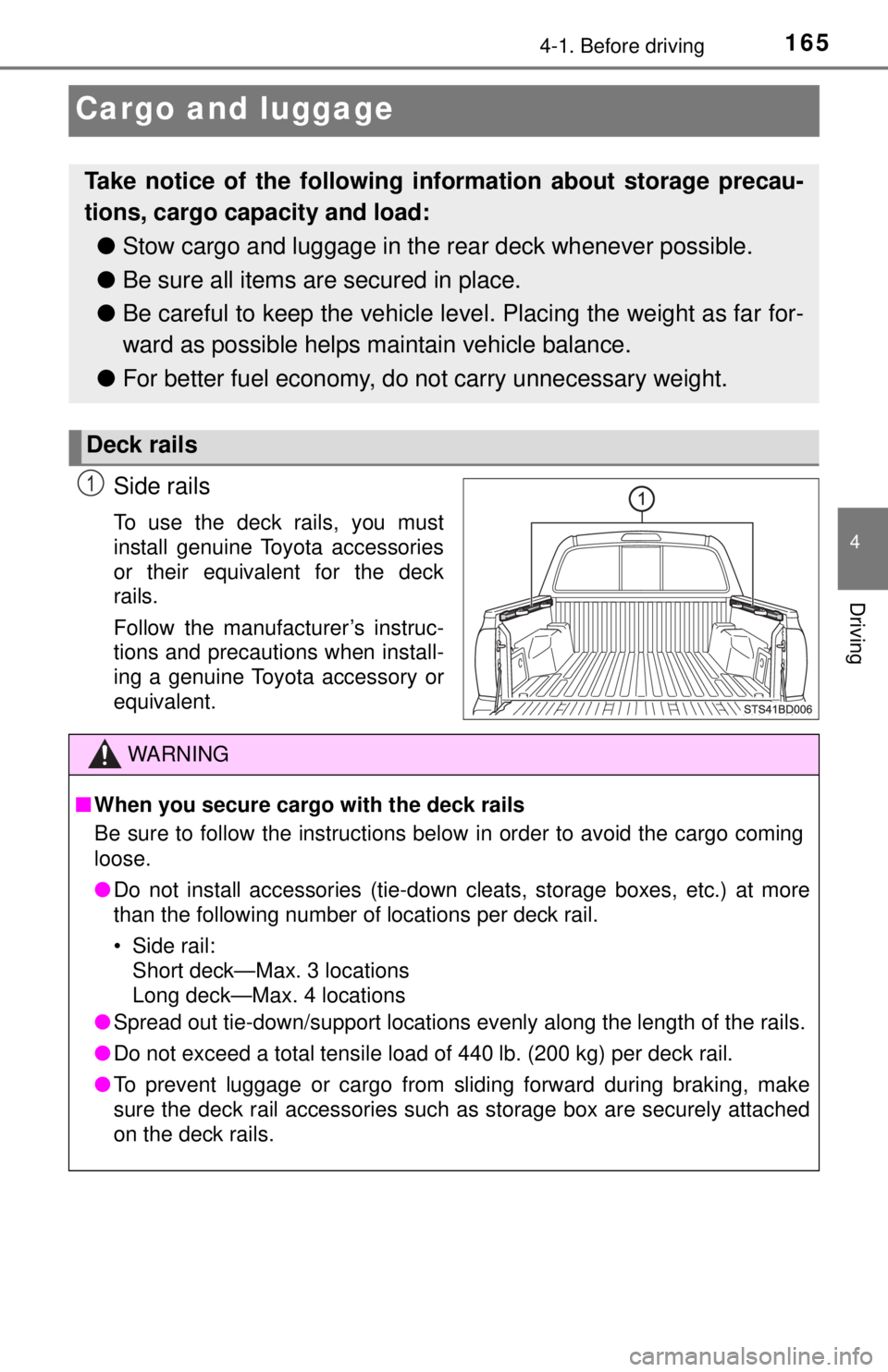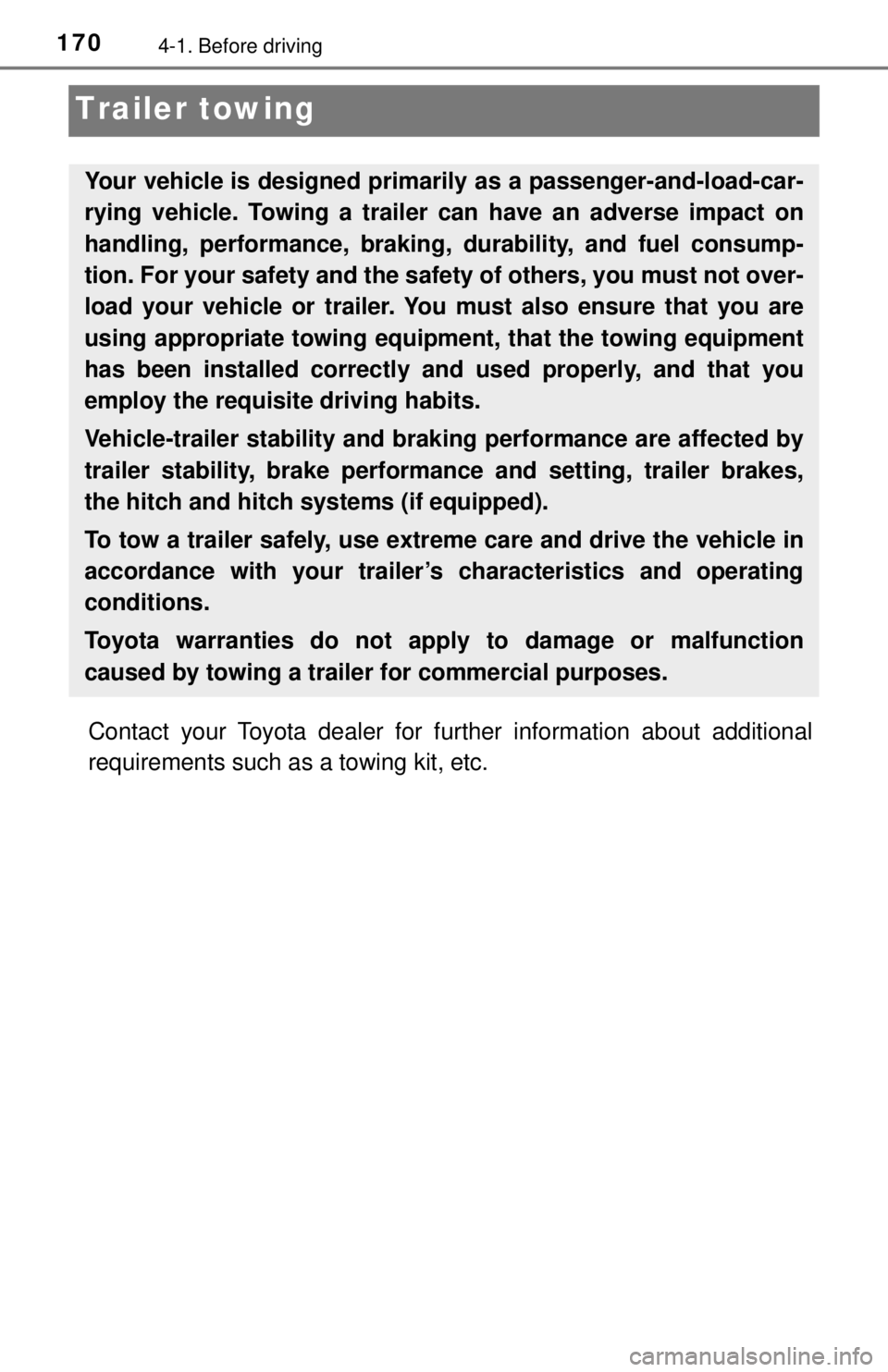Page 165 of 640

1654-1. Before driving
4
Driving
Cargo and luggage
Side rails
To use the deck rails, you must
install genuine Toyota accessories
or their equivalent for the deck
rails.
Follow the manufacturer’s instruc-
tions and precautions when install-
ing a genuine Toyota accessory or
equivalent.
Take notice of the following information about storage precau-
tions, cargo capacity and load:● Stow cargo and luggage in the rear deck whenever possible.
● Be sure all items are secured in place.
● Be careful to keep the vehicle leve l. Placing the weight as far for-
ward as possible helps maintain vehicle balance.
● For better fuel economy, do not carry unnecessary weight.
Deck rails
1
WARNING
■When you secure cargo with the deck rails
Be sure to follow the instructions below in order to avoid the cargo coming
loose.
● Do not install accessories (tie-down cleats, storage boxes, etc.) at more
than the following number of locations per deck rail.
• Side rail:
Short deck—Max. 3 locations
Long deck—Max. 4 locations
● Spread out tie-down/support locations evenly along the length of the rails.
● Do not exceed a total tensile load of 440 lb. (200 kg) per deck rail.
● To prevent luggage or cargo from sliding forward during braking, make
sure the deck rail accessories such as storage box are securely attached
on the deck rails.
Page 170 of 640

1704-1. Before driving
Trailer towing
Contact your Toyota dealer for further information about additional
requirements such as a towing kit, etc.
Your vehicle is designed primarily as a passenger-and-load-car-
rying vehicle. Towing a trailer can have an adverse impact on
handling, performance, braking, durability, and fuel consump-
tion. For your safety and the safe ty of others, you must not over-
load your vehicle or trailer. You must also ensure that you are
using appropriate towing equipmen t, that the towing equipment
has been installed correctly an d used properly, and that you
employ the requisite driving habits.
Vehicle-trailer stability and braking performance are affected by
trailer stability, brake performance and setting, trailer brakes,
the hitch and hitch systems (if equipped).
To tow a trailer safely, use extreme care and drive the vehicle in
accordance with your trailer’s characteristics and operating
conditions.
Toyota warranties do not appl y to damage or malfunction
caused by towing a trailer for commercial purposes.
Page 198 of 640
1984-2. Driving procedures
*1: To improve fuel efficiency and reduce noises, set the shift lever in the Dposition for normal driving.
*2: Selecting shift ranges using S mode restricts the upper limit of the possiblegear ranges, controls engine braking forces, and prevents unnecessary
upshifting.
Use when high levels of response and feeling are desirable, such as
when driving in mountainous regions or when pulling a trailer.
Press the “ECT PWR” button to select power mode.
The “ECT PWR” indicator comes on.
Press the button again to cancel power mode.
Shift position purpose
Shift positionFunction
PParking the vehicle/starting the engine
RReversing
NNeutral
(Condition in which the power is not transmitted)
DNormal driving*1
SS mode driving*2 ( →P. 199)
Selecting power mode
Ty p e AType B
Page 208 of 640

2084-3. Operating the lights and wipers
With the headlights on, push
the lever away from you to turn
on the high beams.
Pull the lever toward you to the
center position to turn the high
beams off.
Pull the lever toward you and
release it to flash the high
beams once.
You can flash the high beams with the headlights on or off.
■Daytime running light system
●To make your vehicle more visible to other drivers during daytime driving,
the front turn signal/parking lights (bul b type) or the parking lights (LED type)
turn on automatically whenever the engine is started and the parking brake
is released with the headlight switch in the “AUTO” (type A), “DRL” (type B)
or (type C) position. (Illuminate brighter than the front turn signal/
parking lights [bulb type] or the parking lights [LED type]). Daytime running
lights are not designed for use at night.
● Compared to turning on the headlights, the daytime running light system
offers greater durability and consumes less electricity, so it can help improve
fuel economy.
■ Headlight control sensor (vehicles wi th an automatic light control sys-
tem)
Turning on the high beam headlights
1
2
The sensor may not function properly if an
object is placed on the sensor, or anything
that blocks the sensor is affixed to the
windshield.
Doing so interferes with the sensor
detecting the level of ambient light and
may cause the automatic headlight sys-
tem to malfunction.
Page 214 of 640
2144-4. Refueling
Opening the fuel tank cap
●Vehicles without a smart key system:
Turn the engine switch to the “LOC K” position and ensure that all
the doors and windows are closed.
● Vehicles with a smart key system:
Turn the engine switch off and ens ure that all the doors and win-
dows are closed.
● Confirm the type of fuel.
■Fuel types
→P. 581
Perform the following steps to open the fuel tank cap:
Before refueling the vehicle
Page 215 of 640

2154-4. Refueling
4
Driving
WARNING
■When refueling the vehicle
Observe the following precautions while refueling the vehicle.
Failure to do so may result in death or serious injury.
● After exiting the vehicle and before opening the fuel door, touch an
unpainted metal surface to discharge any static electricity. It is important to
discharge static electricity before refueling, because sparks resulting from
static electricity can cause fuel vapors to ignite while refueling.
● Always hold the grips on the fuel tank cap and turn it slowly to remove it.
A whooshing sound may be heard when the fuel tank cap is loosened.
Wait until the sound cannot be heard before fully removing the cap. In hot
weather, pressurized fuel may spray out the filler neck and cause injury.
● Do not allow anyone that has not discharged static electricity from their
body to come close to an open fuel tank.
● Do not inhale vaporized fuel.
Fuel contains substances that are harmful if inhaled.
● Do not smoke while refueling the vehicle.
Doing so may cause the fuel to ignite and cause a fire.
● Do not return to the vehicle or touch any person or object that is statically
charged.
This may cause static electricity to build up, resulting in a possible ignition
hazard.
■ When refueling
Observe the following precautions to prevent fuel overflowing from the fuel
tank:
● Securely insert the fuel nozzle into the fuel filler neck.
● Stop filling the tank after the fuel nozzle automatically clicks off.
● Do not top off the fuel tank.
NOTICE
■Refueling
Do not spill fuel during refueling.
Doing so may damage the vehicle, such as causing the emission control
system to operate abnormally, or dam aging fuel system components or the
vehicle’s painted surface.
Page 216 of 640
2164-4. Refueling
Open the fuel filler door.
Turn the fuel tank cap slowly
open.
After refueling, turn the fuel tank
cap until you hear a click. Once
the cap is released, it will turn
slightly in the opposite direction.
Opening the fuel tank cap
1
2
Closing the fuel tank cap
Page 217 of 640
2174-4. Refueling
4
Driving
■Fuel tank opening for unleaded gasoline
To help prevent incorrect fueling, y our vehicle has a fuel tank opening that
only accommodates the special nozzle on unleaded fuel pumps.
WARNING
■ When replacing the fuel tank cap
Do not use anything but a genuine Toyota fuel tank cap designed for your
vehicle. Otherwise, doing so may cause a fire or other incident which may
result in death or serious injury.